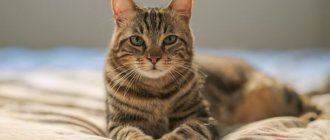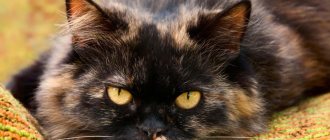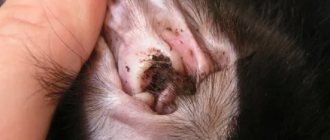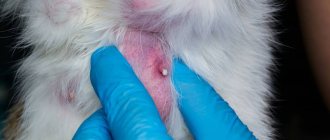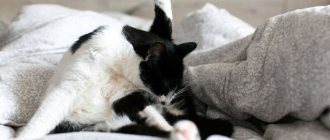You don't always have to worry if your cat has a black nose. The color of a cat's nose always depends on the color of its coat; animals are black and their nose will be black by nature. White cats also have a white or pink nose, red cats have an orange nose, motley animals can even boast mottled or freckled ones. But a change in the color of the nose or the appearance of black crusts or spots on it is always an alarming symptom. If your cat's nose suddenly turns black, this is a reason to contact a veterinarian as soon as possible.
Injuries
The cat's nose is a very sensitive and delicate organ; it is naturally constantly moisturized, for this reason its damaged skin takes a long time to heal. If there is no doubt that the cause of the appearance of black crusts on the nose is an injury, then the cat will not require special treatment. After the damaged tissue is restored, the crust will fall off on its own. Only if weeping wounds or ulcers appear, the nose should be treated with an antiseptic.
Black cats will always have black noses too.
Infections
Your cat's ears are going bald: causes of baldness and treatment options
Black crusts on the nose of cats, along with purulent discharge, can be symptoms of infectious diseases. To successfully treat an infection, you should first undergo tests (skin scraping and nasal swab) to determine the nature of the disease. In case of infection, the affected areas are treated with chlorhexidine (Miramistin) and lubricated with levomekol or other antibacterial agents as recommended by a doctor.
The color of a cat's nose always matches the color of its coat.
Important! If left untreated, infectious diseases can lead to complications or even death of the animal.
We should not forget that the health of mustachioed babies, like any children, is more fragile than that of adult animals, so a kitten’s dirty, crusty nose requires immediate action and timely treatment.
You should pay special attention to the health of kittens
Prevention
Preventive measures to prevent the development of purulent rhinitis involve regular examinations by veterinary specialists. This allows you to promptly identify possible anomalies in the structure of the nasal septum or other pathologies. At the slightest sign of your pet's ill health, you should contact a veterinarian for advice.
The development of dangerous viral diseases accompanied by profuse purulent discharge from the nose can be prevented by timely immunization of the cat. The necessary criterion is proper nutrition and maintaining the body’s defenses at the proper level.
Skin diseases
The cat is drooling: the main causes and treatment options
If you have a fungal infection, the crusts on your cat's nose may appear black or brown. Fungal diseases should be treated with antifungal agents, such as clotrimazole or fungin.
If a cat has black nasal discharge, this may be a consequence of otitis media or a symptom of a mite or fungus entering the sinuses and developing inflammation. To help your cat, you should get tested (scraping from the affected area) as soon as possible and, depending on the results, select a suitable treatment regimen from your veterinarian. To alleviate your pet’s condition, before receiving test results and starting treatment, you can carefully clean the nose and rinse it with warm water or chamomile decoction.
Black crusts under a cat's nose may be the result of a fungal infection.
Allergic rhinitis in cats
If you observe watery discharge accompanied by sneezing, it usually means your cat has ingested or inhaled an allergen from the environment. Allergies to non-food irritants, also known as atopy, were most likely inherited by your cat from her parents.
Note! Atopic allergy is an increased sensitivity to common allergens: plants and their waste products, mold, insect bites and dust mites, etc.
Symptoms of infectious diseases
A cat's tooth fell out: main symptoms and treatment options
Cats are by nature predators and pack animals, so they try not to show their weakness. In order not to miss the onset of the disease and to treat your pet at the initial stage, you should carefully monitor its behavior and condition. A cat's dirty nose is a serious symptom that should not be ignored. And in a small kitten, discharge from the nose and eyes can lead to serious consequences or even a threat to life.
Nasal discharge
If a kitten has pus flowing from its nose, this is a very dangerous symptom. Discharge is a consequence of a malfunction of the mucous membranes. If the irritation is caused by a foreign body entering the nostril, then purulent or bloody discharge will come from one nostril.
Clear discharge from both nostrils accompanied by sneezing is most likely the result of an allergy. Thick, opaque pus coming from a cat's nose is a sign of a respiratory infection or rhinitis. If the purulent discharge is thick, yellow or dark in color with an unpleasant odor, then most likely there is a bacterial infection.
If you notice discharge from your cat's nose, you should contact your veterinarian without wasting any time.
Important! If you find discharge from a cat's nose, you should not think for a long time about what to do, but you need to contact a veterinarian as soon as possible and begin treatment, since with serious inflammation, days can count.
Conjunctivitis
Conjunctivitis, an inflammation of the mucous membrane of the eye, is a common disease in cats. Its causes can be very different: inflammation of the eyelids, infectious diseases, injuries or allergies. Inflammation can also occur from irritation of the mucous membrane, for example, from aerosols or cigarette smoke, so you should monitor the cleanliness of the air in the room where pets are kept. Depending on the severity, there are four types of conjunctivitis:
- catarrhal - the most harmless. Transparent drops, similar to tears, are released from the eyes. Sometimes it may be accompanied by an increase in temperature. This is the mildest type of this disease, which with proper treatment goes away easily and quickly, leaving no complications;
- purulent. Thick yellow or green discharge flows from the eyes, sometimes smelling foul. The cause of purulent conjunctivitis is most often inflammation of an infectious nature;
- the danger of phlegmonous conjunctivitis is that pus not only comes out, but also accumulates inside the eye, which can lead to serious complications;
- The most severe type of conjunctivitis is follicular. This is a chronic disease in which the eye follicles begin to rot. Requires complex and lengthy treatment under the constant supervision of a veterinarian.
For your information! If conjunctivitis is not treated on time, the animal may go blind.
Otitis
Purulent otitis in cats is a common and dangerous disease, the causes of its occurrence, as well as the symptoms, can be different:
- mechanical damage. Foreign objects entering a cat's ear can damage delicate tissues, which in turn can lead to infection and inflammation;
- various parasites;
- The main symptom of an allergy is itching. The animal scratches the damaged areas, and dirt getting into the scratches can lead to infection;
- the fungus provokes the development of purulent inflammation;
- Viral pathologies are complications that arise due to improper treatment or its absence.
Important! If the cat does not receive timely treatment, then not only the ear, but also the meninges become inflamed, which can lead to meningitis.
Decreased appetite
Decreased appetite along with nasal discharge may be a sign of a cold in an animal. Snot from a cold is viscous and transparent. In case of serious complications, thick discharge and crusts may appear on the face. If a pet constantly breathes through its mouth, then this also indicates a cold, since its nose is blocked with pus and there is not enough oxygen.
Lethargy
A healthy animal should be active, cheerful and playful. If the cat has become apathetic, uninterested in anything, and has trouble standing on its paws, this is a reason to sound the alarm. Lethargy can be a symptom of diseases such as asthma, bartonellosis, kidney disease, pancreatitis, infectious peritonitis, plague, and many others.
When should an owner sound the alarm?
Black dots on the nose that have developed for pathological reasons, due to hormonal, systemic disruptions in the body, may be accompanied by the following symptoms:
- itching, scratching on the face;
- restless behavior;
- the appearance of a skin rash, bald patches on the body;
- poor coat quality;
- dry nose;
- unstable temperature;
- decreased activity;
- refusal of food;
- increased thirst;
- skin inflammation;
- the appearance of scabs, dry crusts on the nose;
- swelling.
If dark dots, spots of different diameters, increase in size, are distributed throughout the animal’s body, ulcers are noticeable, or other signs that are not typical for a healthy cat, it would be a good idea to show your pet to a veterinarian, since such symptoms may signal the development of neoplasia and skin cancer.
Malignant pigment spots have a dirty yellow, brown, dark brown color with a reddish tint, and uneven edges. They may protrude somewhat above the surface of the skin. In severe cases, blackheads can spread throughout the pet's entire body.
Pet treatment
If your cat's nose begins to turn black, you should not self-medicate or waste time. Without special education, it is impossible to establish the exact reason why the nose turned black or discharge began. And not only the pet’s health, but also its life often depends on a timely visit to the veterinarian. It is useful to always have in your phone the contacts of a good veterinary clinic that is open 24 hours a day. One day this could save a pet's life.
Only a veterinarian can correctly diagnose and prescribe treatment for a cat.
Important! It should be remembered that water is much more important than food. The animal will live no more than two days without water, so you need to carefully monitor the pet and, if necessary, forcefully water it from a syringe, after immobilizing its paws.
Care
Before the doctor arrives, the animal should be provided with complete rest. The nose should not be completely cleared of pus so as not to complicate the diagnosis. Excessive heat before the doctor arrives is also not recommended, as this can increase inflammation. After receiving a diagnosis, you should strictly follow all the veterinarian’s instructions for care, treatment and feeding, without skipping procedures.
In addition to direct treatment, a sick animal also needs the care and attention of its owner. You need to find time not only for medical procedures, but also for affectionate communication with your pet. You should also monitor the cleanliness of the animal’s fur, since due to weakness, most likely the cat will not have the strength to maintain it in proper form, and he will be very grateful to the owner for timely combing and cleansing the fur from pus, secretions or food debris.
For a sick animal, the care and attention of the owner is very important
If a cat has a black spot on its nose or any discharge from the nose or eyes, this is always a cause for concern. It should be remembered that people are responsible for those they have tamed. And the owner’s attentive attitude towards his pet is a guarantee of the animal’s health and longevity.
This is simple lentigo
Another possible cause is simply your cat's nose being discolored. Lentigo is the development of small areas of hyperpigmentation on your cat's skin and it is a common occurrence around your cat's nose and mouth, if a black spot is adjacent to your cat's nose and looks like part of the skin, congratulations, your cat essentially has a new freckle.
Lentigo is not dangerous and does not affect your cat's health in any way. Once you notice one lentigo spot, you are likely to see more. The spots look like freckles or age spots; your cat will likely get more, but don't expect any side effects from the spots.

